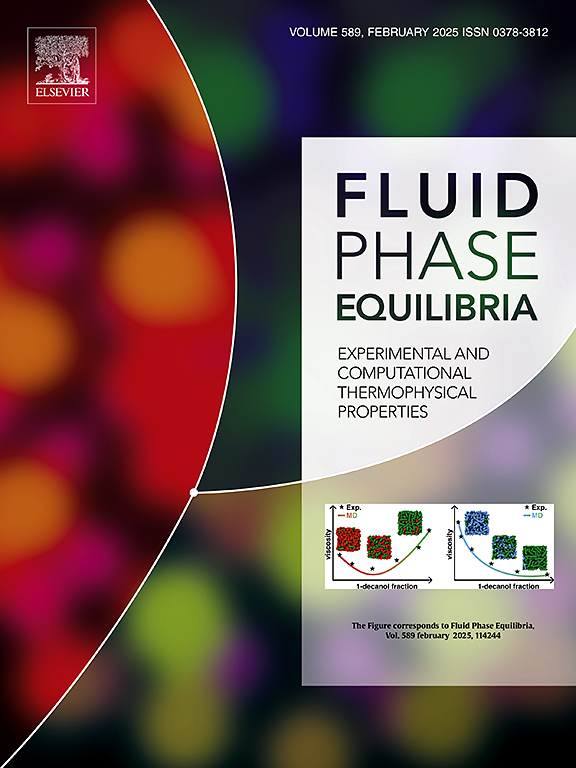Thermodynamic insights into H2O-D2O separation via gas hydrate formation with HFC134a
IF 2.8
3区 工程技术
Q3 CHEMISTRY, PHYSICAL
引用次数: 0
Abstract
This study investigates the thermodynamic phase behavior of mixed H2O and D2O systems using HFC134a gas hydrates, focusing on the potential for separating D2O from H2O. Hydrate formation and dissociation experiments were conducted on pure H2O, D2O, and their 50:50 vol% mixtures. Phase equilibrium data were obtained using the isochoric pressure-volume-temperature (PVT) method, and the Clausius-Clapeyron equation was applied to calculate dissociation enthalpies. The results revealed distinct differences in hydrate stability, with D2O hydrates forming at lower pressures and higher temperatures than H2O. The mixed system exhibited intermediate thermodynamic properties, reflecting the influence of both H2O and D2O within the hydrate. The dissociation enthalpy for H2O+HFC134a is approximately 131.85 kJ/mol, while D2O+HFC134a is about 167.28 kJ/mol. The dissociation enthalpy for the mixed hydrate is approximately 145.23 kJ/mol indicating an increase of about 10.14 % compared to H2O+HFC134a and a decrease of approximately 13.18 % compared to D2O+HFC134a. These findings highlight the potential for using HFC134a hydrates as an effective method for D2O and H2O separation, with future work aiming to explore their thermodynamic regimes and optimize experimental conditions for feasible separation.
求助全文
约1分钟内获得全文
求助全文
来源期刊

Fluid Phase Equilibria
工程技术-工程:化工
CiteScore
5.30
自引率
15.40%
发文量
223
审稿时长
53 days
期刊介绍:
Fluid Phase Equilibria publishes high-quality papers dealing with experimental, theoretical, and applied research related to equilibrium and transport properties of fluids, solids, and interfaces. Subjects of interest include physical/phase and chemical equilibria; equilibrium and nonequilibrium thermophysical properties; fundamental thermodynamic relations; and stability. The systems central to the journal include pure substances and mixtures of organic and inorganic materials, including polymers, biochemicals, and surfactants with sufficient characterization of composition and purity for the results to be reproduced. Alloys are of interest only when thermodynamic studies are included, purely material studies will not be considered. In all cases, authors are expected to provide physical or chemical interpretations of the results.
Experimental research can include measurements under all conditions of temperature, pressure, and composition, including critical and supercritical. Measurements are to be associated with systems and conditions of fundamental or applied interest, and may not be only a collection of routine data, such as physical property or solubility measurements at limited pressures and temperatures close to ambient, or surfactant studies focussed strictly on micellisation or micelle structure. Papers reporting common data must be accompanied by new physical insights and/or contemporary or new theory or techniques.
 求助内容:
求助内容: 应助结果提醒方式:
应助结果提醒方式:


